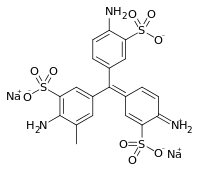Acid fuchsin
 | |
| Names | |
|---|---|
| IUPAC name
Disodium 2-amino-5-[(Z)-(4-amino-3-sulfonatophenyl)(4-iminio-3-sulfonato-2,5-cyclohexadien-1-ylidene)methyl]-3-methylbenzenesulfonate | |
| Identifiers | |
3D model (JSmol) |
|
| ChEBI | |
| ChemSpider | |
| ECHA InfoCard | 100.019.833 |
| EC Number | 221-816-5 |
PubChem CID |
|
| |
| |
| Properties | |
| C20H17N3Na2O9S3 | |
| Molar mass | 585.53 g·mol−1 |
| Hazards | |
| GHS pictograms |  |
| GHS signal word | Warning |
| H315, H319, H335 | |
| P261, P264, P271, P280, P302+352, P304+340, P305+351+338, P312, P321, P332+313, P337+313, P362, P403+233, P405, P501 | |
Except where otherwise noted, data are given for materials in their standard state (at 25 °C [77 °F], 100 kPa). | |
| Infobox references | |
Acid fuchsin or fuchsine acid is an acidic magenta dye with chemical formula C20H17N3Na2O9S3. It has wide use in histology. It is one of the dyes used in Masson's trichrome stain.[1] This method is commonly used to stain cytoplasm and nuclei of tissue sections in the histology laboratory in order to distinguish muscle from collagen. The muscle stains red with the acid fuchsin, and the collagen is stained green or blue with light green SF yellowish or methyl blue. It can also be used to identify growing bacteria.[2]
Formula:
- 1 g of acid fuchsin
- 1 mL of glacial acetic acid (HOAc)
- 100 mL of distilled water
See also
References
- ↑ Jocelyn H. Bruce-Gregorios, M.D.: Histopathologic Techniques, JMC Press Inc., Quezon City, Philippines, 1974. ISBN 971-11-0853-4
- ↑ Holman, W. L (1914). "The use of Decolorized Acid Fuchsin as an Acid Indicator in Carbohydrate Fermentation Tests with some Remarks on Acid Production by Bacteria". Journal of Infectious Diseases. 15: 227–233. doi:10.1093/infdis/15.1.227.
This article is issued from
Wikipedia.
The text is licensed under Creative Commons - Attribution - Sharealike.
Additional terms may apply for the media files.